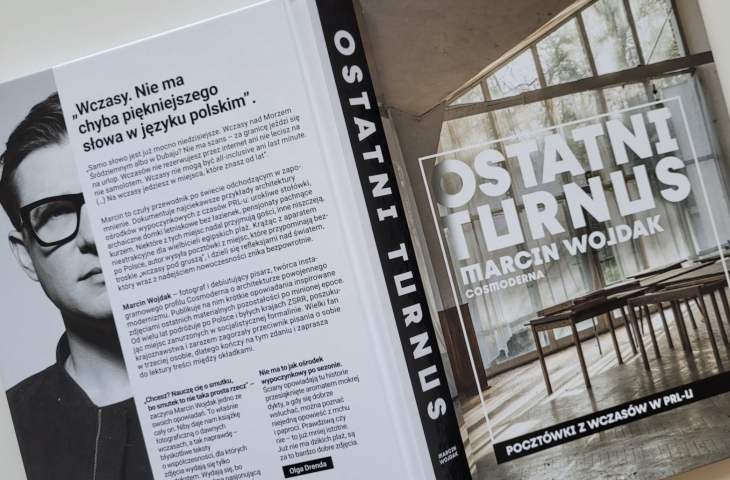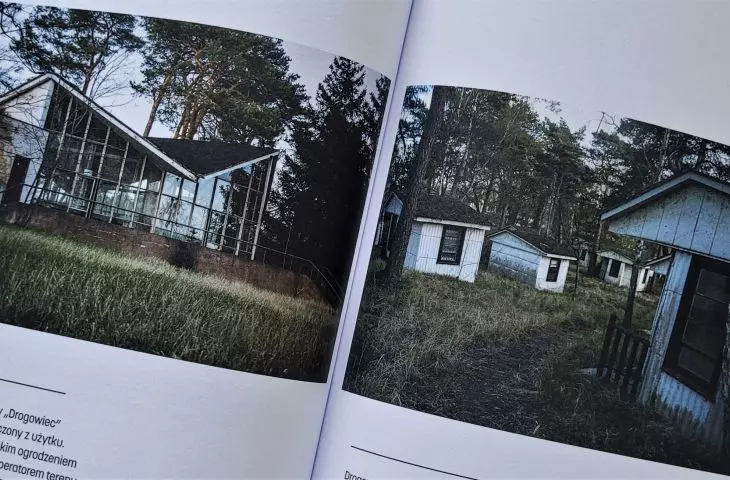Resortsin the People's Republic - a vast and poorly covered topic. Apart from the iconic buildings and complexes, the architecture of the resorts has not lived to see a factual popular description. This gap is also not filled by Marcin Wojdak's "The Last Turnus, " a new publication full of photos of vacationing socmodernism. There are few facts here, instead there are elaborate impressions. A deliberate procedure, but debatable.
This is not the book you're waiting for ," Wojdak warns in various ways in his printed debut, and thus seems to disarm the expected critics. For he senses or knows that readers are hoping for a factual and well-documented compendium about communist holidays and the architecture that serves them. That, however, is absent in Wojdak's work. Instead, there are good, unobvious photographs and writerly impressions, which are far from those photographs.
Marcin Wojdak "The Last Turn" - Znak Publishing House, 2022
photo: Jakub Głaz
instagram impressions
The work published in print is an expansion of the instagram profile Cosmodern, where the author has been posting photos of old holiday resorts for several years. Last winter the photographs and accompanying texts could be seen at an exhibition at the Design Institute in Kielce. Now, at the dawn of the vacations, we received a paperback "Last Turn. Postcards from holidays in the People's Republic of Poland." However, there is not much of People's Poland here - it appears rather as a phantom. The photos are contemporary, as are the related impressions, and in the introduction Wojdak stipulates:
You won't find rich factography here, [...] let alone biographies of the architects who designed the centers. Instead, there will be a lot of dialogue between fictional characters [...]. After I drove several thousand kilometers in search of the most interesting resorts, after I saw hundreds of decaying canteens, piers, thousands of rotten cottages, I realized that it is not their architecture that is the most important here, because this one is sometimes repetitive, but the emotions it evokes, that is, nostalgia, sentiment [...].
photographic synthesis
Marcin Wojdak "The Last Turn" - Znak Publishing House, 2022
photo: Jakub Glaz
So we can forget about the compendium of knowledge. What valuable things do we get in return? First of all, a review of photographs from old resorts. Places scattered across almost all of Poland - known to few, forgotten, abandoned, hidden in forests and behind fences, filled with buildings not mentioned in monographs on post-war architecture. Yes, Wojdak writes about icons, such as the spa in Zawodzie (designed by Henryk Buszko, Aleksander Franta, Tadeusz Szewczyk), but - and this is the great value of his work - he shows less spectacular examples. Thus, we get a cross-sectional synthesis of the communist center, which includes both party centers built on a grand scale and much more modest houses erected by poorer workplaces. Only a few - like the very interesting Poseidon in Jastarnia - are still operating in almost unchanged form. On the other hand, a sizable number are about to disappear, some no longer exist. Others, the author laments, are modified in a nasty way. This makes the documentary value of Wojdak's photos all the greater, with the added value of the emptiness surrounding the buildings. The photos were created in the off-season.
Marcin Wojdak "The Last Turn" - Znak Publishing House, 2022
photo: Jakub Glaz
But will these photographs evoke in readers the aforementioned nostalgia for the phenomenon of vacations, which has grown a thick skin of associations, cultural codes, and has become the subject of songs, film scenes and ironic commentaries of the Polish Film Chronicle? Employees' Holiday Fund, company holidays, turnouts, familiarization evenings, cultural and educational. These words certainly evoke a vivid memory for the elderly, sometimes reinforced by sentiment. For younger people, however, "holidays" is just a pop-culture gadget, inexperienced personally, therefore all the simpler to process and process freely. Simpler seemingly, because it is full of pitfalls.
hills and ditches
Thirty-seven-year-old Wojdak, who, to his regret, never experienced a communist holiday, fell into these traps as well. Although metrically he is located at the junction of the two generations, he is certainly closer to the younger generation. Hence the freedom in spinning impressionistic stories, with which the photographs are interspersed. The level? Be prepared for turbulence. Wojdak sometimes climbs prose hills, but more often lands in deep ditches, especially where he weaves the imaginary dialogues already annotated here into the content. Whether through lack of hearing or modest writing experience, the sentences rustle the paper, on which vulgarities are marked with blobs from time to time. Swearing, a thing that is not infrequently legitimate, but here - despite the loose subject matter - it is administered with a cackle. Nevertheless, the author disarms this objection, too, in one of the contrived dialogues, following the use of "whore" in the form of a comma:
- What's the fuck for here?
- What do you mean why? Without it, it wouldn't be a sentence.
In the stories you will also find a lot of circular interjections on the level of a drunken uncle or the loose chatter of backyard buddies. What's the point? The answer is probably hidden in an interview the author gave to Vogue magazine:
I have an excess of thoughts, I need to liquidate them somewhere, and these texts turned out to be a good way. I write them quite quickly - I look at a photo, look for an association, even the most distant, with a name, some object, anything, and fly.
space to develop
In this way you sometimes learn more about Wojdak himself than about the objects he describes. "The Last Turn" looks as if it were written against an invisible reviewer or editor, who tries unsuccessfully to redirect the author into more rational and coherent areas. The form of the whole thing flounders, disintegrates and decays - as do some of the objects described and photographed. If that was the point, the procedure succeeded. There is consistency of form and content.
However, the work performs best where it provides factual information - in the extensive captions, address details, or some of the text free from too rapid stream of consciousness. One senses that the author knows much more, but doesn't reveal it. Perhaps this is because he doesn't know enough to write a factual yet complete work. Hence the escape into loose impressions, probably. After all, the subject of leisure architecture of the People's Republic of Poland is very capacious and difficult to explore. It is resisted byscattered or lost archives, changing owners, unreliable memory of users. When one does not have the nature of an inquisitive researcher, one can, quite simply, fail. Constantly, therefore, there is space to be developed. If not by a single author, then perhaps by an efficient and well-knit collective - as in the case of "Architecture of the Seventh Day" (Izabela Cichońska, Karolina Popera, Kuba Snopek) or "Altan Atlas" (Wojciech Mazan, Paul Cetnarski, Dominika Dymek, Mirabela Jurczenko, Rafał Śliwa).
The photographic research is already there. Now it's time for decent work.


























